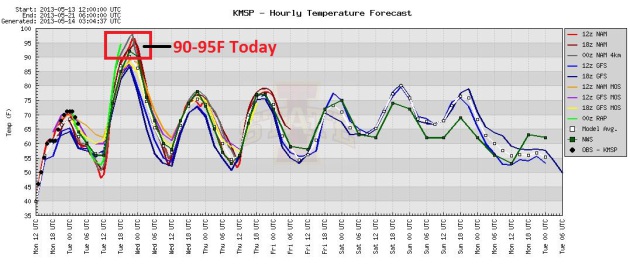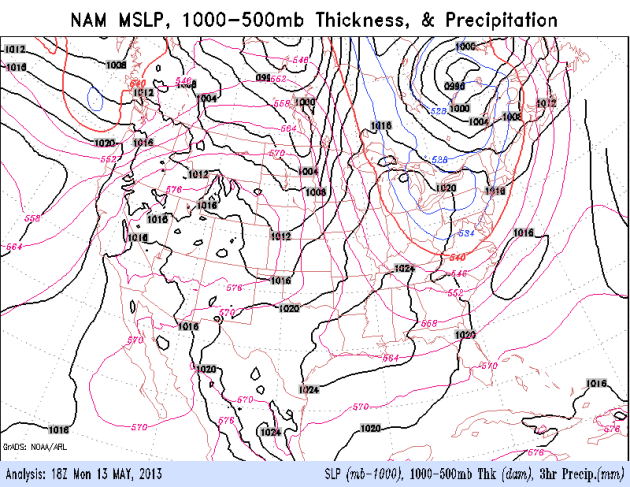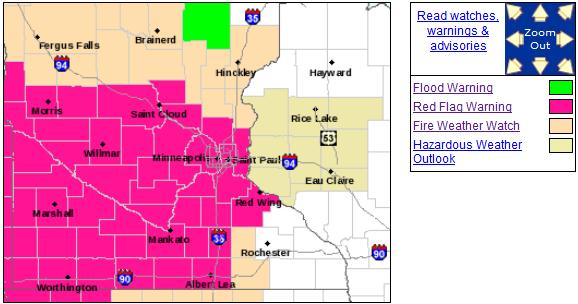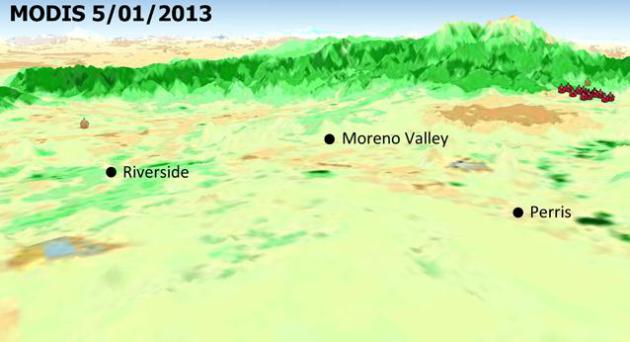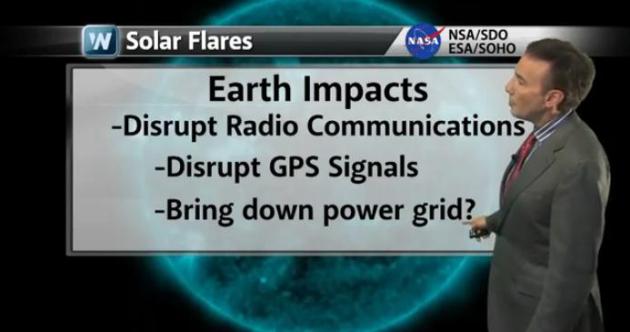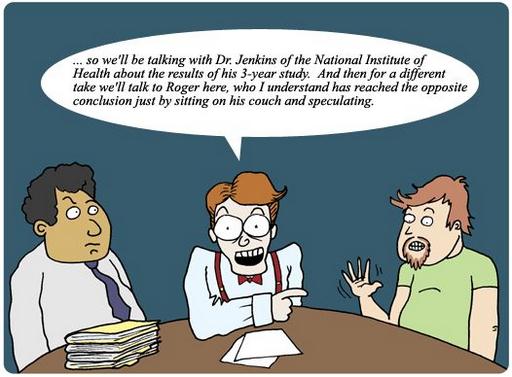"Wummer"
Sometimes you read a story and just shake your
head in utter amazement. Last week saw a rash of 911 calls in Madison -
people reporting "dead bodies" on area lawns. It turns out it was just
sun-starved college kids sunbathing. Yep, reluctant zombies, just trying
to get a tan. Details below.
"I'm calling this WUMMER, Paul. A rude mash-up
of winter and summer...since we never really experienced spring" a
friend complained yesterday. Will this be one of those tentative, sickly
summers, where we celebrate every time we hit 80? No idea, but I
suspect it won't be anything like 2012, when we couldn't buy a cool
front.
Welcome to an All or Nothing May: frost Sunday
morning to low 90s today? Wear a light jacket over your shorts and don't
ask any questions.
A Fire Weather Warning is posted; gusty winds
and low humidity fanning & accelerating any brush fires later today.
We cool off a little Wednesday - 70s into next weekend.
No need to water anytime soon: a series of
storms rippling along an east-west frontal boundary may drop some heavy
rainfall amounts Friday into Tuesday of next week. Minor flooding is
even a possibility. Drought to flood - 30s to 90s?
I can't remember a spring like this.
Heat Spike. All the models show
a high above 90 today; a few suggesting mid-90s. Temperatures cool off
into the 70s Wednesday and Thursday, before rising above 80 again by
Saturday.
Warm And Wet. I suspect the
ECMWF is underestimating today's heat: unless we stay cloudy the mercury
should rise into the upper 80s, with a better chance of low 90s by late
afternoon. Another surge of heat and humidity sparks T-storms Friday,
Saturday and Sunday; temperatures cooling off into the 50s by Tuesday of
next week.
Big Swings. While residents of
New England reach for jackets folks in the Upper Midwest will be
sweating thru a July-like day; 90-degree highs surging into Minnesota by
afternoon. The Southwest remains dry with only spotty instability
T-showers over the Southeast. NAM model loop: NOAA.
High Fire Threat. The Twin Cities National Weather
Service has issued a Red Flag Warning for central and most of southern
Minnesota, which is basically a Fire Warning. Gusty winds, coupled with
sunshine and low humidity (and the fact that we haven't entirely greened
up yet) will accelerate any brushfires that might form today,
especially this afternoon. Details from NOAA:
HOT AND WINDY CONDITIONS WILL ARRIVE ON TUESDAY WITH TEMPERATURES
EXPECTED TO REACH THE MIDDLE 80S TO MIDDLE 90S. SOUTHWEST TO WEST
WINDS FROM 15 TO 25 MPH AND GUSTS OF 30 TO 40 MPH ARE FORECAST
ALONG WITH MINIMUM RELATIVE HUMIDITY VALUES NEAR 20 PERCENT. THIS
CAN RESULT IN DANGEROUS WILDFIRE CONDITIONS TUESDAY AFTERNOON AND
EVENING ACROSS MUCH OF CENTRAL AND SOUTHERN MINNESOTA.
...RED FLAG WARNING IN EFFECT FROM NOON TO 8 PM CDT TUESDAY FOR
WIND AND LOW RELATIVE HUMIDITY FOR MOST OF CENTRAL AND SOUTHERN
MINNESOTA...
THE NATIONAL WEATHER SERVICE IN TWIN CITIES/CHANHASSEN HAS ISSUED
A RED FLAG WARNING FOR WIND AND LOW RELATIVE HUMIDITY...WHICH IS
IN EFFECT FROM NOON TO 8 PM CDT TUESDAY. THE FIRE WEATHER WATCH
IS NO LONGER IN EFFECT.
* WINDS...SOUTH 15 TO 25 MPH WITH GUSTS UP TO 40 MPH...SHIFTING
WEST.
* RELATIVE HUMIDITY...AS LOW AS 20 PERCENT.
* IMPACTS...WILDFIRES COULD BECOME FAST MOVING IN A SHORT PERIOD
OF TIME DUE TO THE STRONG WINDS...LOW HUMIDITY AND DRY FUELS.
PRECAUTIONARY/PREPAREDNESS ACTIONS...
A RED FLAG WARNING MEANS THAT CRITICAL FIRE WEATHER CONDITIONS
ARE EITHER OCCURRING NOW...OR WILL SHORTLY. A COMBINATION OF
STRONG WINDS...LOW RELATIVE HUMIDITY...AND WARM TEMPERATURES CAN
CONTRIBUTE TO EXTREME FIRE BEHAVIOR.

Drought, Cold Cripple Wheat Crop. Here's an excerpt from a story at AP and
NBC News: "
The
winter wheat crop is expected to be far smaller this season compared
to last, particularly for hard red varieties used in bread, the U.S.
Department of Agriculture reported Friday. In the first government
projection on the harvest's anticipated size, the National Agricultural
Statistics Service estimated winter wheat production will be down 10
percent to 1.49 billion bushels, due to fewer acres — 32.7 million
acres, some 6 percent fewer acres than a year ago — and a 1.8-bushel
decrease in average yields, to 45.4 bushels per acre. The government's
forecast comes amid a season marked by drought and late spring freezes
in the Midwest's major wheat growing areas, particularly in Kansas —
the nation's biggest wheat-producing state..."
Photo credit above: Travis Heying / AP. '
Ben McClure
examines a wheat stalk in a Reno County, Kan., wheat field. Forecasts
show a smaller crop due to drought and late-spring cold."
Minnesota Lakes Contaminated With All Kinds of Chemicals. Out of 50 Minnesota lakes studied only 3 were found to be chemical-free. Details from
The Star Tribune: "
Man-made
chemicals, from cocaine to DEET to pharmaceuticals, are finding their
way into Minnesota lakes in ways that no one understands. Some 50 lakes
analyzed last year by state scientists contained at least some of 125
different chemicals. DEET, the insect repellent, was the most common,
found in 76 percent of them. Only three of the 50 lakes were
chemical-free. Bisphenol A, from plastic, was found in nearly half and
cocaine was found in a third, according to a Minnesota Pollution Control Agency analysis made public Monday..."
Photo credit: Lake Nokomis, courtesy of Tom Wallace, Star Tribune.
* The MPCA (Minnesota Pollution Control Agency) reports are
here.
Another Twist To The Weather: Tornadoes Few, Far Between. Here are some interesting stats, part of story at
omaha.com: "...
The
last time Iowa had a confirmed tornado was May 24, 2012. If no
tornadoes occur through Wednesday, the state will surpass the record of
355 days set at the end of April 1956, he said. “To have gone this
long without one is pretty extraordinary,” said John Lee, meteorologist
for the National Weather Service in Des Moines. Harold Brooks,
research meteorologist for the National Severe Storms Laboratory, said
preliminary numbers for May 2012 through April 2013 indicate that 197
tornadoes rated EF1 or stronger occurred in the United States. Lesser
tornadoes weren't factored into his analysis because they cause little
damage and may even have gone unnoticed in the past, so the historical
record is considered suspect..." (Photo: FEMA).
Satellites See Double Jeopardy For SoCal Fire Season.
It's going to be a long, hot, highly flammable fire season for
residents of the west, including Southern California. Here's an excerpt
from a post at NASA's
Jet Propulsion Laboratory: "PASADENA, Calif. -
New
insights into two factors that are creating a potentially volatile
Southern California wildfire season come from an ongoing project using
NASA and Indian satellite data by scientists at NASA's Jet Propulsion
Laboratory, Pasadena, Calif.; and Chapman University, Orange, Calif.
The scientists tracked the relationship between rainfall and the growth
and drying-out of vegetation in recent months, during an abnormally dry
year. They found the timing of rains triggered regional vegetation
growth in January and early February, which then dried out faster than
normal during a period of low rainfall, strong winds and high
temperatures in March and April. The combination likely elevates
wildfire risks by increasing available fuel. The two institutions are
combining satellite datasets to monitor moisture changes in vegetation
and soil across Southern California's vast wilderness areas in order to
identify early warning signs of potential wildfires. The scientists
are using measurements of soil moisture change from the Indian
Oceansat-2 satellite scatterometer (OSCAT) and of vegetation stress
from the Moderate Resolution Imaging Spectroradiometer (MODIS) sensor
on NASA's Aqua satellite..."
Graphic credit above: "
Current
vegetation conditions in Southern California's Riverside County are
illustrated in this image from the Moderate Resolution Imaging
Spectroradiometer (MODIS) sensor on NASA's Aqua spacecraft, acquired on
May 1, 2013. Greener areas indicate more vegetation. Locations where
multiple wildfires erupted in late April and May 1 are marked. See
sidebar image for comparative image acquired Feb. 25, 2013." Image credit: NASA/JPL-Caltech/U.S. Forest Service.
* "
Fierce Fire Season Predicted For West".
USA Today has the story, following up on the JPL press release above.
Solar Cycle Peaks Later This Year - Are You Prepared for Possible Disruptions to Power and Communications?
A potentially disruptive and damaging solar flare is reported on Earth
roughly once a decade. The Earth's rotation around the sun will place
it in a more vulnerable position later in 2013, directly exposed to the
most active portion of the sun and sunspots capable of sparking major
solar flares, including potentially damaging X-Flares, which can
disrupt communications, GPS signals, even the power grid. NASA has a
good overview (
"A Super Solar Flare")
detailing the last time the USA experienced a devastating X-Flare, the
"Carrington Event" in 1859. The odds of a similar event are small,
roughly 12% over the next 11 year cycle. A major geomagnetic storm (G4
or G5 from an X-scale solar flare) could cause major power outages that
might last weeks, months, even years - something none of us want to
think about, but a real risk nonetheless.
A Space Weather Primer. We've experienced 3 separate
X-class solar flares since midday Sunday. The risk of geomagnetic
storms is small, but not zero, and we need to pay attention to "space
weather" in the coming months. The solar cycle peaks later in 2013, but
some of the most intense solar flares and CME's are often observed going
into and coming out of a peak. Details from
WeatherNation TV: "
WeatherNation
Chief Meteorologist Paul Douglas goes over some of the more active
space weather we saw in the past couple of days. Paul Douglas goes over
CMEs and solar flares and how they can impact life on Earth."
First X-Class Solar Flare Of 2013. There were two
CME's (coronal mass ejections), one Sunday evening (X1.7), a second
(X-scale 2.8) Monday morning. A 2.8 flare is nearly 3 times stronger
than an X1. Details from
NASA: "
On
May 12, 2013, the sun emitted a significant solar flare, peaking at 10
p.m. EDT. This flare is classified as an X1.7, making it the first
X-class flare of 2013. The flare was also associated with another solar
phenomenon, called a coronal mass ejection (CME) that can send solar
material out into space. This CME was not Earth-directed. Solar flares
are powerful bursts of radiation. Harmful radiation from a flare cannot
pass through Earth's atmosphere to physically affect humans on the
ground, however -- when intense enough -- they can disturb the
atmosphere in the layer where GPS and communications signals travel.
This disrupts the radio signals for as long as the flare is ongoing –
the radio blackout associated with this flare has since subsided..."
Image credit above: "
The sun erupted with an X1.7-class
solar flare on May 12, 2013. This is a blend of two images of the flare
from NASA's Solar Dynamics Observatory: One image shows light in the
171-angstrom wavelength, the other in 131 angstroms."
Credit: NASA/SDO/AIA
U.N.: Eat More Insects; Good For You, Good For World. Tempting, but no thanks. If you're more adventurous than I am check out this story from AP and
Yahoo News; here's an excerpt: "...
Scientists
who have studied the nutritional value of edible insects have found
that red ants, small grasshoppers and some water beetles pack
(gram-per-gram or ounce-per-ounce) enough protein to rank with lean
ground beef while having less fat per gram. Bored with bran as a source
of fiber in your diet? Edible insects can oblige, and they also contain
useful minerals such as iron, magnesium, phosphorous, selenium and
zinc.
WHICH TO CHOOSE?
Beetles and caterpillars are the most common meals among the more
than 1,900 edible insect species that people eat. Other popular insect
foods are bees, wasps, ants, grasshoppers, locusts and crickets. Less
popular are termites and flies, according to U.N. data..."
Photo credit above: Associated Press/Arnold Van Huis, FAO, ho - "
This
Feb. 20, 2008 photo provided by the United Nations Food and
Agriculture Organization (FAO) shows insects for sale at a market in
Chiang Mai, Thailand. The U.N.
has new weapons to fight hunger, boost nutrition and reduce pollution,
and they might be crawling or flying near you right now: edible
insects."
A "Pet Glacier". O.K. During the last ice age the
ice sheets were more than a mile thick, but it's a real disconnect
looking out at your green lawn, watching wind-whipped ice from Lake
Mille Lacs being pushed ont your yard. Thanks to Patricia Swanson for
sharing this.
Before Calling 911 , Check To See If Person Lying On Grass Is Dead. Need a good laugh? Check out this excerpt of a story at
madison.com: "
Following
the zombie scare on Monday, dead people kept popping up all over
Madison on Tuesday. Or, at least it seemed that way to the Dane County
911 Center. The center was overwhelmed with calls from cellphone users
reporting people lying on the grass, not moving, possibly not living.
Not so. Check the weather. "Please tell cellphone users that people
lying in the grass are not necessarily dead," a dispatcher at the 911
center told Madison.com..."
Climate Stories...
Shell To Develop World's Deepest Offshore Platform.
Reuters has the story; here's an excerpt: "
Royal
Dutch/Shell said on Wednesday it will go ahead with the world's
deepest offshore oil and gas production project, pushing the boundaries
of technology to produce from nearly 2 miles (3.2 km) down in the Gulf
of Mexico.
Coming three years after the Macondo oil spill disaster, Shell targets
first production by 2016, demonstrating confidence in big offshore
projects in spite of a downturn in oil prices. Earlier this week,
Exxon Mobil Corp flagged startup for a $4 billion project to develop
the Julia oilfield, about 40 miles (64 km) west of Stones in the Gulf's
deepest waters..."
Climate Change, "Happy Plants", And False Balance. Here's an excerpt from
Media Matters: "
Carbon dioxide levels in the atmosphere passed
400 parts per million (ppm) on Thursday for the first time in human
history. But one thing hasn't changed: false balance still crops up in
climate change stories. False balance occurs when journalists give equal weight to arguments from both sides, regardless of where the facts lie. Climate change is a textbook example of this problem -- in fact, the term was coined in academic papers to criticize climate coverage in the 1990s. Yet 20 years later, we still get articles like this from Bloomberg News, reporting on the 400 ppm milestone:
Happy Plants
"The Earth has had many-times-higher levels of CO2 in the past," said Marc Morano, former spokesman for Republican Senator James Inhofe and executive editor of Climate Depot,
a blog that posts articles skeptical of climate change. "Americans
should welcome the 400 parts-per-million threshold. This means that
plants are going to be happy, and this means that global-warming
fearmongers are going to be proven wrong..."
What's In A Number? New Carbon Dioxide Level Unseen In Human History. Here's an excerpt from
ABC News: "...
What
worries scientists in 2013 is not only the amount of CO2 in the
atmosphere, but how fast it continues to build up without showing any
sign of slowing or even stabilizing. Today's rate of carbon dioxide
increase is more than 100 times faster than the increase that occurred
when the last ice age ended, NOAA said today. At this rate, even 400
ppm will soon vanish in the rearview mirror. Unless emissions are
slowed, scientists tell us that babies being born today will enter
their thirties as the CO2 level reaches 450 ppm..." (Image credit
here).
Climate Sensitivity Stunner: Last Time CO2 Levels Hit 400 Parts Per Million The Arctic Was 14F Warmer. Here's an excerpt from
Think Progress: "...
At
the same time, a major new Science study of paleoclimate temperatures —
based on ”the longest sediment core ever collected on land in the
Arctic” – revealed what happened the last time we had similar CO2 levels:
“One of our major findings is that the Arctic was very warm in
the Pliocene [~ 5.3 to 2.6 million years ago] when others have
suggested atmospheric CO2 was very much like levels we see today. This
could tell us where we are going in the near future. In other words, the Earth system response to small changes in carbon dioxide is bigger than suggested by earlier models,” the authors state.
....How sensitive is the climate to increases in CO2, according to this “absolutely new knowledge” of paleoclimate temperatures?
Another significant finding to emerge from this first
continuous, high-resolution record of the Middle Pliocene is
documentation of sustained warmth with summer temperatures of about 59
to 61 degrees F [15 to 16 degrees C], about 8 degrees C [14 F] warmer
than today..."
Graphic credit above: "
Arctic sea ice is melting much,
much faster than even the best climate models had projected (actual
observations in red). The reason is most likely unmodeled amplifying
feedbacks. The image (from Climate Crocks via Arctic Sea Ice Blog) comes from a 2007 GRL research paper by Stroeve et al."
Terrible News About Carbon And Climate Change. Let's
hope the markets respond (when a price is finally put on carbon
pollution, like any other form of pollution). Then wait for the climate
change-equivalent of Apple, Google or Tesla. Here's an excerpt of a post
at
The New Yorker: "...
We’ve failed collectively. As Ryan Lizza explained
in miserable detail in 2010, the United States government couldn’t
pass a tepid, eviscerated law. Activists have failed. We’ve all failed
morally: a problem created by the world’s rich will now crush the
world’s poor. In a grand sense it’s also a failure of the creators, and
deniers, of climate change: the Exxon-Mobils, say, or the Wall Street
Journal editorial page.
A victory isn’t worth much if your children and grandchildren will one
day think of you with anger and shame. How do we get out of this mess?
The political system seems hopeless. Yes, government regulation has
done much to relieve us of acid rain and smog. But global warming
combines two intractable problems. Reducing emissions mainly benefits
people who aren’t born and don’t vote. And it requires international
coördination, which is hopeless, and international law, which is
toothless. We should do things like build more public transportation,
which helps people here and now. We should design our cities for a
future with terrible weather. But solving the problem of climate change
through the U.N. is like a small man with olive oil on his hands
trying to pull a whale from the water...."
The True Cost Of Climate Change? Here's a look at
home changing climate and weather patterns (and availability of fresh
water) may impact species and biodiversity, from
Birdwatch: "
Accelerating
world climate change will radically decrease two thirds of common
plants and half the animals, says new research from the University of
East Anglia (UEA). Research published today in the journal Nature
Climate Change look at 50,000 globally widespread and common species,
and found that two thirds of the plants and half of the animals will
lose more than half of their climatic range by 2080, if nothing is done
to reduce the amount of global warming and slow it down. This means
that geographical ranges of common plants and animals will shrink
globally, and biodiversity will decline almost everywhere. Almost two
thirds of common plants and half the animals could see a dramatic
decline this century due to climate change..."
China "Moving To Lead On Climate Change", Says
Report. Wait, this is the same country that's been launching roughly one
new coal-fired power plant every week; a country where, at times, you
can't breathe the air, drink the water or eat the food? The Chinese
realize they have a serious environmental problem, and renewable energy
provides the only way out. Here's an excerpt from
Climate Central: "...
The
report says China and the U.S., the world’s two largest economies
which together produce about 37 percent of world emissions, are both on
track to meet their international commitments on climate change,
something they said in this month’s “historic agreement” they would
tackle together. “Today the energy giants are undoubtedly on the move,
which will fuel global momentum.” China earns praise for several
reasons. It is reducing its emissions growth, and in 2012 cut the
carbon intensity of its economy more than expected. After years of
strong growth in coal use, the rate of growth has declined
substantially. It is also “the world’s renewable energy powerhouse.”
Professor Flannery says: “China has halved its growth in electricity
demand… [and] is quickly moving to the top of the leader board on
climate change...”
Graphic credit above: "
Global progress on renewable energy graphic." Credit: Climate Commission.

